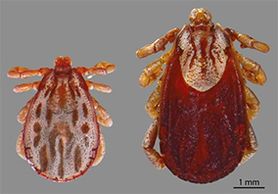TICKS IN MAINE
BLACKLEGGED OR DEER TICK
BLACKLEGGED OR DEER TICK
BLACKLEGGED OR DEER TICK
.jpg/:/cr=t:0%25,l:0%25,w:100%25,h:100%25/rs=w:388,h:194,cg:true)
The deer tick (Ixodes dammini) was once considered a unique species. It is now known to be the same as a previously described species—the blacklegged tick (Ixodes scapularis). Adult males are very dark brown, almost black. Adult females are two-toned: dark chestnut brown on head and legs, and orange-red on the rear half of the body. Nymphs are about the size of a pinhead; adults are 2 to 3 mm long. In Maine, the adult tick population in certain sites may be more than 50% infected, rates vary considerably even in nearby areas. Adult blacklegged ticks are more heavily infected with B. burgdorferi (lyme)(30-60%) than the nymphs because the tick has had two opportunities to become infected, once as a larva and once as a nymph.
AMERICAN DOG TICK
BLACKLEGGED OR DEER TICK
BLACKLEGGED OR DEER TICK
.jpg/:/cr=t:0%25,l:0%25,w:100%25,h:100%25/rs=w:388,h:194,cg:true)
The American dog tick, Dermacentor variabilis, is found throughout the eastern United States and is the most frequently encountered tick in Maine. Known by some people as the "wood tick," only adults of the American dog tick are usually found feeding on people and pets. The American dog tick can transmit a pathogen that causes Rocky Mountain spotted fever, but this disease has not been reported in Maine. The dog ticks do not transmit Lyme. Adult American dog ticks are reddish brown with white markings on the back or upper body. They are about 1 /4 of an inch long. Female ticks increase dramatically in size as they obtain their blood meal from a host animal. Fully engorged females, smooth and shiny, may reach 1 /2 inch in length. Male ticks do not change in size as they feed.
BROWN DOG OR KENNEL TICK
BLACKLEGGED OR DEER TICK
BROWN DOG OR KENNEL TICK
.jpg/:/cr=t:0%25,l:0%25,w:100%25,h:100%25/rs=w:388,h:194,cg:true)
The brown dog tick or kennel tick, is widely distributed worldwide, but uncommon in Maine. This tick rarely bites people; dogs are the principal host. It has not been associated with Lyme disease transmission. Brown dog ticks are most often found in and around pet bedding areas. It has a strong tendency to crawl upwards, and hides in cracks in kennel roofs or in ceilings or porches. In heated buildings, it occurs at any time of the year. It is unlikely this tick would be found anywhere except areas near kennels or houses where dogs are kept.
WOODCHUCK TICK
WINTER OR MOOSE TICK
BROWN DOG OR KENNEL TICK

The woodchuck tick is widely distributed in Maine. It has not been associated with Lyme disease transmission but is known to be a vector of Powasson virus. It usually feeds on wild animals, such as woodchucks and raccoons, but will readily feed on humans and domestic animals.
WINTER OR MOOSE TICK
WINTER OR MOOSE TICK
WINTER OR MOOSE TICK

The winter tick is found on moose, deer and occasionally horses, cows, dogs and humans, particularly in central and northern Maine. Large numbers of the tiny larvae may be encountered in the fall, especially in areas where moose are found. This tick has not been associated with Lyme disease.
RABBIT TICK
WINTER OR MOOSE TICK
WINTER OR MOOSE TICK
.jpg/:/cr=t:0%25,l:0%25,w:100%25,h:100%25/rs=w:388,h:194,cg:true)
The rabbit tick, is usually found only on rabbits and birds. It may carry the Lyme disease bacteria but it has not been associated with Lyme disease in humans
TICKS IN MAINE
LONE STAR TICK
LONE STAR TICK
LONE STAR TICK

The Lone Star tick is becoming more common in Maine. It is often associated with travelers from southern states where it is very common. It has been shown to carry a disease organism that may produce a rash in humans and some symptoms similar to Lyme disease.
SQUIRREL TICK
LONE STAR TICK
LONE STAR TICK

This tick has not been associated with Lyme disease. It is commonly found on squirrels but will occasionally bite humans
IXODES MURIS
LONE STAR TICK
IXODES ANGUSTUS

Is occasionally found in Maine. It is usually associated with voles and mice, but it may bite humans, cats, dogs, and birds. Preliminary work indicates it is a weak vector of Lyme disease.
IXODES ANGUSTUS
IXODES ANGUSTUS
IXODES ANGUSTUS

Is common in many parts of Maine and usually found only on voles and mice. It is very rarely found on humans or domestic animals. Its potential role in Lyme disease transmission is being investigated.
IXODES BRUNNEUS
IXODES ANGUSTUS
IXODES BRUNNEUS
-0001.jpg/:/cr=t:0%25,l:0%25,w:100%25,h:100%25/rs=w:388,h:194,cg:true)
Is found on migratory birds in Maine but rarely .